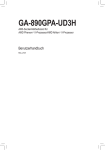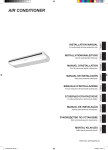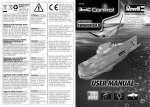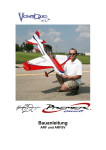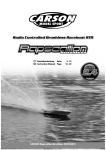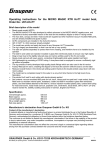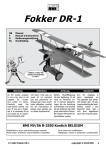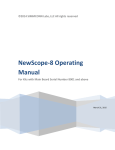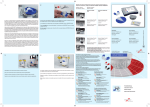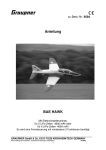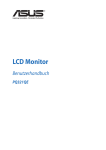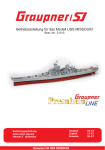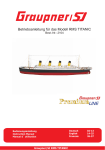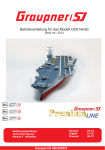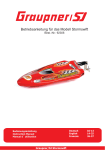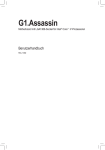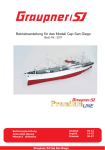Download GRAUPNER & Co. KG D-73230 KIRCHHEIM/TECK GERMANY
Transcript
Bauanleitung für das Modell Powercat, Best.-Nr.: 2125 Beschreibung des Originals Class 1 Offshore Rennkatamarane sind Boote mit einer länge von 12-14m. Sie erreichen Endgeschwindigkeiten von 250 km/h und mehr. Aus dem maximal zulässigen 8,2 Litern Hubraum werden ca. 750 - 950 PS mobilisiert. Seit Beginn der Saison 2003 kommen ausschließlich V 12 Benzinmotoren der Firma Lamborghini zum Einsatz. Die Besatzung eines Class 1 Bootes besteht aus dem Fahrer und dem sog. Throttleman. Das Modell entstand in Anlehnung der berühmten Class 1Powerboote. Ähnlich der Formel 1 Szene werden jedes Jahr rund um den Erdball verschiedene Rennen ausgetragen. Beschreibung des Modells Dieses Modell ist für den Einsteiger und den Fortgeschrittenen geeignet. Es wurde bei der Konstruktion besonders auf einfache Bauweise und hohe Festigkeit geachtet. Der Bau erfordert wenig modellbauerische Kenntnisse. Alle Teile sind passgenau lasergeschnitten und die Tiefziehteile gefräst, sodass kaum Nacharbeit entsteht. Der Antrieb erfolgt mit einem Mittelantrieb oder nach eigenem Ermessen mit 2 Antrieben in den Schwimmern. Geeignet sind Bürsten-oder bürstenlose Motoren. Technische Daten Länge Rumpf ca. Länge ü.a. ca. Breite ca. Höhe o.Ruder ca. Gesamtgewicht mit RC ca. Maßstab ca. 785 mm 895 mm 240 mm 160 mm 2,0 - 2,2 kg je nach Motor und Akku 1:12 Herstellererklärung der Fa. Graupner GmbH & Co KG Inhalt der Herstellererklärung Sollten sich Mängel an Material oder Verarbeitung an einem von uns in der Bundesrepublik Deutschland vertriebenen, durch einen Verbraucher (§ 13 BGB) erworbenen Gegenstand zeigen, übernehmen wir, die Fa. Graupner GmbH & Co KG, Kirchheim/Teck im nachstehenden Umfang die Mängelbeseitigung für den Gegenstand. Rechte aus dieser Herstellererklärung kann der Verbraucher nicht geltend machen, wenn die Beeinträchtigung der Brauchbarkeit des Gegenstandes auf natürlicher Abnutzung, Einsatz unter Wettbewerbsbedingungen, unsachgemäßer Verwendung (einschließlich Einbau) oder Einwirkung von außen beruht. Diese Herstellererklärung lässt die gesetzlichen oder vertraglich eingeräumten Mängelansprüche und -rechte des Verbrauchers aus dem Kaufvertrag gegenüber seinem Verkäufer (Händler) unberührt. Umfang der Garantieleistung Im Garantiefall leisten wir nach unserer Wahl Reparatur oder Ersatz der mangelbehafteten Ware. Weitergehende Ansprüche, insbesondere Ansprüche auf Erstattung von Kosten im Zusammenhang mit dem Mangel (z.B. Ein-/Ausbaukosten) und der Ersatz von Folgeschäden sind – soweit gesetzlich zugelassen – ausgeschlossen. Ansprüche aus gesetzlichen Regelungen, insbesondere nach dem Produkthaftungsgesetz, werden hierdurch nicht berührt. Voraussetzung der Garantieleistung Der Käufer hat den Garantieanspruch schriftlich unter Beifügung des Originals des Kaufbelegs (z.B. Rechnung, Quittung, Lieferschein) und dieser Garantiekarte geltend zu machen. Er hat zudem die defekte Ware auf seine Kosten an die folgende Adresse einzusenden. Fa. Graupner GmbH & CO KG, Serviceabteilung, Henriettenstr.94 -96, D 73230 Kirchheim/Teck GRAUPNER GmbH & Co. KG D-73230 KIRCHHEIM/TECK GERMANY Keine Haftung für Druckfehler. Technische Änderungen vorbehalten! #0059939 04/2008 1 Der Käufer soll dabei den Material- oder Verarbeitungsfehler oder die Symptome des Fehlers so konkret benennen, dass eine Überprüfung unserer Garantiepflicht möglich wird. Der Transport des Gegenstandes vom Verbraucher zu uns als auch der Rücktransport erfolgt auf Gefahr des Verbrauchers. Gültigkeitsdauer Diese Erklärung ist nur für während der Anspruchsfrist bei uns geltend gemachten Ansprüche aus dieser Erklärung gültig. Die Anspruchsfrist beträgt 24 Monate ab Kauf des Gerätes durch den Verbraucher bei einem Händler in der Bundesrepublik Deutschland (Kaufdatum). Werden Mängel nach Ablauf der Anspruchsfrist angezeigt oder die zur Geltendmachung von Mängeln nach dieser Erklärung geforderten Nachweise oder Dokumente erst nach Ablauf der Anspruchsfrist vorgelegt, so stehen dem Käufer keine Rechte oder Ansprüche aus dieser Erklärung zu. Verjährung Soweit wir einen innerhalb der Anspruchsfrist ordnungsgemäß geltend gemachten Anspruch aus dieser Erklärung nicht anerkennen, verjähren sämtliche Ansprüche aus dieser Erklärung in 6 Monaten vom Zeitpunkt der Geltendmachung an, jedoch nicht vor Ende der Anspruchsfrist. Anwendbares Recht Auf diese Erklärung und die sich daraus ergebenden Ansprüche, Rechte und Pflichten findet ausschließlich das materielle deutsche Recht ohne die Normen des Internationalen Privatrechts sowie unter Ausschluss des UN-Kaufrechts Anwendung. Wichtige Sicherheitshinweise Sie haben ein Modell erworben, aus dem – zusammen mit entsprechendem geeignetem Zubehör – ein funktionsfähiges RC-Modell fertig gestellt werden kann. Die Einhaltung der Montage- und Betriebsanleitung im Zusammenhang mit dem Modell sowie die Installation, der Betrieb, die Verwendung und Wartung der mit dem Modell zusammenhängenden Komponenten können von GRAUPNER nicht überwacht werden. Daher übernimmt GRAUPNER keinerlei Haftung für Verluste, Schäden oder Kosten, die sich aus dem fehlerhaften Betrieb, aus fehlerhaftem Verhalten bzw. in irgendeiner Weise mit dem Vorgenannten zusammenhängend ergeben. Soweit vom Gesetzgeber nicht zwingend vorgeschrieben, ist die Verpflichtung der Firma GRAUPNER zur Leistung von Schadensersatz, aus welchem Grund auch immer ausgeschlossen (inkl. Personenschäden, Tod, Beschädigung von Gebäuden sowie auch Schäden durch Umsatz- oder Geschäftsverlust, durch Geschäftsunterbrechung oder andere indirekte oder direkte Folgeschäden), die von dem Einsatz des Modells herrühren. Die Gesamthaftung ist unter allen Umständen und in jedem Fall beschränkt auf den Betrag, den Sie tatsächlich für dieses Modell gezahlt haben. Die Inbetriebnahme und der Betrieb des Modells erfolgt einzig und allein auf Gefahr des Betreibers. Nur ein vorsichtiger und überlegter Umgang beim Betrieb schützt vor Personen- und Sachschäden. Prüfen Sie vor dem ersten Einsatz des Modells, ob Ihre Privat-Haftpflichtversicherung den Betrieb von Modellschiffen dieser Art mit einschließt. Schließen Sie gegebenenfalls eine spezielle RC-ModellHaftpflichtversicherung ab. Diese Sicherheitshinweise müssen unbedingt aufbewahrt werden und bei einem Weiterverkauf des Modells an den Käufer weitergegeben werden. Folgende Punkte müssen unbedingt beachtet werden: • Das Modell ist nicht für Kinder unter 14 Jahren geeignet. • Die hervorstehenden Teile an dem Modell können scharf sein und die Antennen können Augenverletzungen hervorrufen. • Beachten Sie beim Einsatz von Werkzeugen die möglichen Gefahren durch diese. • Das Modell niemals betreiben, wenn sich Menschen und Tiere im Wasser befinden! Da, bedingt durch die hohe Geschwindigkeit des Modells, eine erhebliche Verletzungsgefahr für diese besteht. • Lassen Sie Ihr Modell nicht in Naturschutz-, Landschaftsschutz-, oder Gewässerschutzgebieten fahren. Informieren Sie sich bei Ihrer Gemeinde über die für den Schiffsmodellbau freigegebenen Gewässer. • Fahren Sie niemals im Salzwasser. • Fahren Sie niemals bei widrigen Witterungsbedingungen, wie z.B. Regen, Gewitter, stärkerem Wind sowie höherem Wellengang, Strömung des Gewässers usw. • Beachten Sie die Empfehlungen und Hinweise zu Ihrer Fernsteuerung und Zubehörteilen. GRAUPNER GmbH & Co. KG D-73230 KIRCHHEIM/TECK GERMANY Keine Haftung für Druckfehler. Technische Änderungen vorbehalten! #0059939 04/2008 2 • • • • • • • • • • • • • • • • • • • Kontrollieren Sie, bevor Sie das Modell fahren lassen, dieses auf eine sichere Funktion der Fernsteuerung sowie die Steckverbindungen auf sichere und feste Verbindung. Trockenbatterien zur Stromversorgung dürfen niemals nachgeladen werden. Nur Akkus dürfen nachgeladen werden. Die Reichweite der Fernsteuerung muss vor Fahrtbeginn überprüft worden sein. Laufen Sie hierzu mit eingeschaltetem Modell ca. 100 m vom Sender weg, ein Helfer bedient währenddessen den Sender. Hierbei müssen alle Funktionen problemlos ausgeführt werden können. Prüfen Sie, ob der von Ihnen genutzte Kanal frei ist. Fahren Sie niemals, wenn Sie sich nicht sicher sind, ob der Kanal frei ist. Beachten Sie, dass Funkgeräte oder Sendeanlagen die Funktion des Modells stark stören können. Achten Sie möglichst darauf, dass keines dieser Geräte in der Nähe betrieben wird während Sie das Modell betreiben. Arbeiten Sie nur an den Antriebsteilen, wenn der Fahrakku nicht angeschlossen ist. Bei angeschlossenem Fahrakku dürfen Sie und andere Personen niemals in den Bereich der drehenden Antriebsteile, besonders der Schiffsschrauben, kommen. Die empfohlene Betriebsspannung nicht übersteigen. Eine höhere Spannung kann zum Überhitzen der Motoren bzw. des Fahrtreglers führen oder die elektrischen Leitungen können durchschmoren. Dadurch kann das Modell zerstört werden. Achten Sie auf Leichtläufigkeit aller Antriebskomponenten. Dies gilt besonders während des Fahrbetriebs, da sich Blätter und andere Dinge im Antrieb verfangen können. In einem solchen Fall können die Motoren bzw. der Fahrtregler durch Überlast zerstört werden. Die Batterie und Akkus dürfen nicht kurzgeschlossen werden, sowie nicht direkt dem Wasser ausgesetzt werden. Entnehmen Sie den Fahrakku und die Senderbatterien bzw. -akkus bei Nichtgebrauch des Modells. Setzen Sie das Modell nicht starker Luftfeuchtigkeit, Hitze, Kälte sowie Schmutz aus. Sichern Sie das Modell und den Sender beim Transport gegen Beschädigung sowie Verrutschen. Betreiben Sie niemals das Modell an einem stark bewegten Wasser (z.B. Fluss), da bei einem evtl. Defekt das Modell abtreiben kann. Bringen Sie bei einer evtl. Bergung des Modells sich nicht selbst sowie andere in Gefahr. Achten Sie besonders auf die Wasserdichtheit des Modells. Ein Modellboot wird bei entsprechendem Wassereinbruch sinken. Kontrollieren Sie das Modell vor jeder Fahrt, ob irgendeine Beschädigung vorliegt und ob Wasser durch die Antriebs- bzw. Ruderwellen eindringen kann. Lassen Sie das Modell nach Gebrauch gut austrocknen. Kontrollieren Sie unbedingt während der ersten Fahrt mehrmals, ob die Wellenanlagen wasserdicht sind. Wenn Wasser eindringt, demontieren Sie die Wellen und schmieren die Stevenrohre mit ausreichend Fett (Best.-Nr. 570) nach. HINWEIS: die im Modell verbauten Elektromotoren dürfen nicht im Hausmüll entsorgt werden, sie müssen demontiert werden und separat an der zuständigen Entsorgungsstelle abgegeben werden. Pflege und Wartung • • • Säubern Sie das Modell nach jedem Gebrauch. Entfernen Sie evtl. eingedrungenes Wasser. Sollte Wasser in die RC-Komponenten gedrungen sein, legen Sie diese trocken und schicken Sie die RCKomponenten zur Kontrolle an die zuständige GRAUPNER Servicestelle ein. Säubern Sie das Modell und den Sender nur mit geeigneten Reinigungsmitteln. Geeignet ist ein fusselfreies Tuch. Verwenden Sie niemals chemische Reiniger, Lösungsmittel, Reinigungsbenzin, Spiritus oder ähnliches. Schmieren Sie die Antriebswellen nach Ende des Betriebs mit einem kleinen Tropfen Öl an den Lagern ab. Auch die äußeren Wellenlager bei den Propellern müssen geschmiert werden. Verwenden Sie zum Schmieren der Antriebe nur Öl, welches das Wasser nicht gefährdet bzw. verschmutzt (z.B. Best.-Nr. 206). Nach Ende der Fahrsaison sollten die Wellen demontiert werden und mit wasserneutralem Fett (z.B. Best.-Nr. 570) neu abgeschmiert werden. Montageanleitung • Überprüfen Sie den Inhalt des Baukastens anhand der Stückliste. • Alle Kunststoffteile sollten von Trennmittelresten gereinigt werden. Verwenden Sie dazu eine Spülmittellösung. • An den Klebestellen das ABS mit feinem Schmirgelpapier leicht aufrauen. • Stellen Sie das Unterwasserteil (Teil 1) auf eine ebene Unterlage. • Zeichnen Sie mit einem Bleistift eine Linie 2 mm unterhalb der Fräskante von innen an die Bordwand. GRAUPNER GmbH & Co. KG D-73230 KIRCHHEIM/TECK GERMANY Keine Haftung für Druckfehler. Technische Änderungen vorbehalten! #0059939 04/2008 3 • Schneiden Sie von dem ABS Profil 3x3mm (Teil 2) 12 Stücken von ca. 20mm Länge ab. 3 2 1 • Diese Stücke kleben Sie im Abstand von ca. 120mm (von hinten gemessen) unterhalb entlang der Linie Verwenden Sie UHU-Plast spezial oder Sekundenkleber. • Entnehmen Sie der 4mm Sperrholzplatte die Heckverstärkung (Teil 3) streichen es mehrmals mit Glattfix (Best. 207) und kleben Sie es von innen gegen den Spiegel (Stabilit oder Sekundenkleber). • Wichtig: Die Bohrungen und Schlitze dürfen nicht mit Klebstoff verschlossen werden • Lösen Sie aus der 1mm Sperrholzplatte die Teile 4, 5 und 6 und entfernen eventuelle Grate. • Kleben Sie den Schwimmerspant (Teil 4) von unten in die Schlitze des Horizontalspanten (Teil 6). • Teil 5 kleben Sie von oben in die hinteren Schlitze des Horizontalspanten. • Achtung die Spanten senkrecht zum Teil 6 aufkleben • Ist das Gerippe getrocknet, mit Porenfüller mehrmals streichen, um die Sperrholzeile wasserfest zu bekommen. 6 5 4 • Die beiden hinteren Zapfen von Teil 6 stecken Sie bis zum Anschlag in die Schlitze des Heckspiegels. • Legen Sie den Horizontalspant auf die seitlich im Rumpf angeklebten ABS-Profile (Teile 2). • Wichtig: Das Spantgerippe verzugfrei einkleben! Dazu das Bootsunterteil mit den Schwimmern auf eine ebene Fläche legen und in das Boot ein Gewicht legen, um es in dieser Position zu halten! GRAUPNER GmbH & Co. KG D-73230 KIRCHHEIM/TECK GERMANY Keine Haftung für Druckfehler. Technische Änderungen vorbehalten! #0059939 04/2008 4 verkleben Spant herunterdrücken einstecken • • • • Die Schwimmer müssen an den 6 Abreißkanten bis zum Aushärten auf einer ebenen Unterlage aufliegen! Den Ringspant (6) mit Sekundenkleber auf die ABS Profile (2) heften. Nach Aushärtung verkleben Sie den Ringspant mit der Bordwand des Unterteils mit Stabilit oder Acrylit. Spant 4 wird am Boden nur punktförmig verklebt. Fertigen Sie aus den Teilen 7 und 8 die Servohalterung und kleben Sie diese mit Stabilit in dem Schlitz des Heckspantes und auf den Rumpfboden. 3 mit Stabilit verkleben 7 8 Wichtig • Das Modell mit Gewicht auf der Unterlage belassen und das Oberteil anpassen. • Zuerst den vorderen Bereich vom Ober- und Unterteil mit Stabilit einstreichen und passend auf das Unterteil setzen. GRAUPNER GmbH & Co. KG D-73230 KIRCHHEIM/TECK GERMANY Keine Haftung für Druckfehler. Technische Änderungen vorbehalten! #0059939 04/2008 5 • Sichern Sie das Oberteil auf dem Unterteil mit einigen Klebestreifen. 9 Zuerst diesen Bereich mit Stabilit verkleben Die Klebestreifen nur am Heckspiegel und den vorderen Mittelteil verwenden, um Verzug zu vermeiden. • • • • • • • Ist der Klebstoff ausgehärtet, das Gewicht entnehmen und das Boot umdrehen. Die Klebestreifen am Heck entfernen und die mittlere Fläche im Heckbereich mit Stabilit bestreichen, und an den Heckspiegel drücken, bis zum Aushärten mit Klebestreifen sichern. Wichtig: Zum Aushärten des Klebers das Modell wieder mit den Gleitkufen auf die ebene Unterlage stellen und mit dem Gewicht belasten. Nach dem Aushärten des Klebstoffes drehen Sie das Boot um (auf das Deck legen). Jetzt wird die Sicke der Oberschale rings um das Boot mit dickflüssigem Sekundenkleber oder UHUPlast spezial verklebt. Wichtig! bei den seitlichen Verklebungen keine Klebestreifen verwenden, um Beulen in der Rumpfseite zu vermeiden. Nach Aushärtung die Spalten ringsum mit Klebstoff auffüllen. GRAUPNER GmbH & Co. KG D-73230 KIRCHHEIM/TECK GERMANY Keine Haftung für Druckfehler. Technische Änderungen vorbehalten! #0059939 04/2008 6 2. dann diesen Bereich mit Stabilit verkleben 3. mit Sekundenkleber dickflüssig oder UHU-plast-spezial verkleben, nach Aushärtung mit Klebstoff auffüllen Wichtig keine Klebestreifen verwenden • • • • • • • • aufbohren (7mm) Nach dem Aushärten des Klebers drehen Sie das Modell um und verkleben Sie die Oberschale mit dem Unterteil von innen, indem Sie den Klebstoff entlang der Rille oberhalb des Ringspantes laufen lassen. Bohren Sie die beiden 7mm Löcher des Spant 3 durch die Heckflächen. Um das Abrisskanten des Rumpfes zu schärfen und die Geschwindigkeit, sowie die Stabilität des Bootes zu erhöhen, können von unten die Laufflächen 18 mit Sekundenkleber aufgeklebt werden. Die seitlichen Spalten können verspachtelt werden, ist aber nicht notwendig. Bauen Sie nun aus den 4mm Laserteilen den Bootsständer entsprechend der Zeichnung zusammen. Lackieren Sie den Ständer mehrmals mit Glattfix (Best.Nr. 207), um den Ständer wasserfest zu machen. Kleben Sie mit Kontaktkleber (Best.Nr.1096) auf die Bootsauflage je ein aufgeschlitztes Stück Silikonschlauch, um Beschädigungen des Modells zu vermeiden. Nach der Aushärtung können Sie das Modell auf dem Ständer abstellen. 15 12 14 11 10 13 GRAUPNER GmbH & Co. KG D-73230 KIRCHHEIM/TECK GERMANY Keine Haftung für Druckfehler. Technische Änderungen vorbehalten! #0059939 04/2008 7 • • • • • • • • • • • • • Kleben Sie die beiden Sperrholzunterlagen 16 des Motorträgers im Abstand von 190mm mit Stabilit auf die Mittelfläche des Rumpfes. 0 19 Bohren Sie im Abstand von 5 13 105 und 135 mm von der Hinterkante je ein 4-5mm 5 10 Loch genau in den Mittelknick durch den Rumpfboden. Schneiden Sie mit einem Cuttermesser den Steg zwischen den Bohrungen heraus. Vorsicht! Abrutschgefahr Nicht zu 19 sehr aufdrücken, Lieber 16 mehrmals schneiden. Schrauben Sie nun die Ruderanlage mittig an das 18 Heck des Rumpfes. 17 Schieben Sie die Flexwelle durch den Strut und das gebohrte Loch im Bootsboden 31 Löten Sie an den Motor den Entstörkondensator 30 (31) über beide Anschlussfahnen und die 32 Motoranschlußkabel (32) an. Von dem Motorträger (19) sägen sie das überstehende Teil ab. Schrauben Sie den Motor an den Träger. Schrauben Sie die Kupplung auf die Motorwelle. Stecken Sie die Kupplung mit Motor auf die Flexwelle. Den vorbereiteten Sperrholzträger schieben Sie zwischen die Sperrholzunterlagen (16) und den Kunststoffmotorträger (19). Durch Abschleifen passen Sie den Sperrholzträger an die 19 Unterlagen an. absägen Wichtig! Die Flexwelle darf keinen Knick bekommen. Sie sollte einen leichten Bogen vom Strut zur Motorkupplung beschreiben. Das Langloch im Bootsboden muss eventuell nachgearbeitet werden. Den Motorträger kleben Sie, wenn alles passt, mit Stabilit auf die Unterlagen. Ist der Klebstoff getrocknet ziehen Sie die Flexwelle heraus und schieben über das Teflonrohr das Alu-Schutzrohr und montieren das Teflonrohr vom Strut ins Bootsinnere. Erweitern Sie jetzt das Langloch im Boden bis das Alurohr, ohne die Welle zu biegen, durchpasst. Verschrauben Sie die Flexwelle mit der Motorkupplung und verkleben Sie das Alu-Schutzrohr mit Stabilit im Bootsboden von innen und außen. Die Flexwelle sollte sich leicht drehen. auf 2mm für Gestängeanschluss aufbohren • 24 23 Die Löcher im Lenkhebel des Ruders auf 2mm aufbohren und den Gestängeanschluss montieren, er muss im Ruderhebel drehbar sein. 20 21 22 GRAUPNER GmbH & Co. KG D-73230 KIRCHHEIM/TECK GERMANY Keine Haftung für Druckfehler. Technische Änderungen vorbehalten! #0059939 04/2008 8 Montieren Sie die dem Servo mitgelieferten Gummilager und stecken Sie von unten die Messinghülsen in die Öffnungen der Gummilager. TIPP: Stecken Sie die Messinghülsen zum Montieren auf einen passenden Schraubendreher. • Schrauben Sie den Servo in den Servohalter gemäß den Zeichnungen. • Aus der Tiefziehplatte den Lufteinlass 26 ausschneiden. Die Schneidelinie ist auf der Innenseite mit einer Wulst markiert. Die Schnittkante gerade verschleifen und an die Vorderkante des Luftrohres ankleben. Den Lufteinlass nicht durchbohren oder öffnen. Das kann beim Umschlagen des Bootes zum Wassereinbruch und damit zum Untergang führen. • Es sind zwei verschiedene Lufthutzen im Bausatz enthalten. Je nachdem, welches Bootsdesign man nachbauen möchte, können die Lufthutzen 27 oder 28 ausgewählt werden. • Die Teile werden ebenfalls an der inneren Wulst als Markierung ausgeschnitten, plan geschliffen und die Hälften miteinander verklebt. • Verwenden Sie Stabilit, Acrylit oder UHU plast spezial. Nach dem Trocknen die Klebenaht von außen verspachteln und schleifen. Kleben Sie die Lufthutzen auf die Ansatzstutzen, ohne diese zu öffnen. • Die Auspuffrohre 29 mittig teilen von hinten stumpf an die Lüftersockel kleben ohne diese zu öffnen. • 28 29 27 26 25 • • • • • • • • • • • • • • • • • Lackierung. Verschleifen Sie alle Klebenähte, evtl. verspachteln. Ritzen können mit UHU-plast-spezial aufgefüllt werden. Nach dem Bearbeiten der Klebenähte und Ritzen schleifen Sie das Boot und den Deckel komplett zuerst mit 400er bis 600er Schleifpapier oder Schleifvlies mit leichten kreisenden Bewegungen. Waschen Sie dann vom Boot den Schleifstaub und das Trennmittel mit einer Spülmittellösung ab. Lackieren Sie das Boot am Besten mit Sprühfarben oder Airbrush. Durch die großen glatten Flächen ist das Modell hervorragend für Airbrushbilder geeignet. Die optimalen Farben erfragen Sie bitte im Modellbau- oder Farb-Fachhandel. Wählen sie ein Farbsystem, welches auf ABS-Kunststoff sicher hält. Mischen Sie nicht die einzelnen Farbsysteme (Hersteller) untereinander. Nitrofarben sind nicht zu empfehlen, da diese den Kunststoff anlösen. Nach dem Trocknen der Farbe montieren sie wieder die Ruderanlage, Welle und den Motor Kleben Sie die Gummitüllen mit Sekundenkleber wasserdicht in die 7mm Löcher des Heckspiegels Schrauben sie die Gabelköpfe auf die Rudergestänge. Fetten oder ölen Sie die Rudergestänge leicht ein und stecken Sie diese von innen durch die Gummitüllen Klicken Sie die Gabelköpfe im Servoarm in das äußere Loch. Stecken Sie die Rudergestänge durch die Gummimanschette. Kleben Sie den Empfänger mit Klettband rechts neben die Servohalterung Schließen Sie den Servo an den Empfänger an. Schließen Sie den Fahrtenregler an den Empfänger an. Schalten Sie den Sender ein und bringen alle Trimm- und Steuerhebel in Neutralstellung GRAUPNER GmbH & Co. KG D-73230 KIRCHHEIM/TECK GERMANY Keine Haftung für Druckfehler. Technische Änderungen vorbehalten! #0059939 04/2008 9 Fahrtregler Verbindungskabel Best.Nr 3031 Schließen Sie einen der Fahrakkus an den Fahrtenregler an, der Servo und der Regler gehen jetzt in Mittelstellung • Stellen Sie die Ruderanlage in Mittelstellung und Schrauben Sie die Rudergestänge in den Gestängeanschlüssen fest. • Falls notwendig, können Sie jetzt den Fahrregler programmieren. Informieren Sie sich dazu in der Anleitung Ihres Reglers. Den Dekorbogen entsprechend der Kartonabbildungen aufbringen. Fahrbetrieb: Die beiden Akkus werden mit Klettband in den beiden Schwimmern befestigt. Die Lage der Akkus muss durch Fahrversuche ermittelt werden. Der Schwerpunkt liegt bei 165mm vor der Hinterkante der Schwimmer. Trimmen des Modells Legen Sie das Modell auf einen Tisch Die beiden Schlitzschrauben auf der rechten Seite des Ruderauslegers lösen und den Neigungswinkel und Höhe des Struts einstellen. Der Strut sollte wie der Rumpf auf dem Tisch aufliegen Die optimale Einstellung muss durch Probefahrten gefunden werden. Das Modell sollte bei Gleitfahrt waagerecht liegen. Wasserkühlung • Schrauben Tischkante Wichtig: Die Schrauben wieder festziehen. GRAUPNER GmbH & Co. KG D-73230 KIRCHHEIM/TECK GERMANY Keine Haftung für Druckfehler. Technische Änderungen vorbehalten! #0059939 04/2008 10 Stückliste Powercat Teil Nr. Anzahl Bezeichnung 1 1 Bootsunterteil 2 0.5m ABS Vierkantprofil 3 1 Heckverstärkung 4 1 Spant für Schwimmer 5 1 Decksspant 6 1 Horizontalspant 7 1 Servohalterung oben 8 2 Servohalterung Seite 9 1 Bootsoberteil 10 2 Ständerstrebe Seite 11 1 Ständerstrebe oben 12 2 Keile 13 2 Träger 14 0,25m Silikonschlauch 15 6 Gleitflächen 16 2 Unterlage für Motorträger 17 1 Motorträgerhalter vorn 18 2 Motorträgerhalter seitlich 19 1 Motorträger 20 1 Ruderanlage mit Strut 21 1 Flexwelle mit Teflonrohr 22 1 Schutzrohr 23 2 Gummimanschette 24 2 Gestängeanschluss 25 2 Deckel 26 2 Lufteinlass vorn 27 2 Lufteinlass gebogen (zweiteilig) 28 2 Lufteinlass (zweiteilig) 29 1 Auspuffrohre 30 1 Motor Speed 700 31 1 Kondensator 32 1 Kabel 2,5mm² 33 1 Stecker + Buchse G2 1 Satz 34 1 Dekorbogen Material ABS Tiefziehteil ABS Profil Sperrholz 4mm Sperrholz 1mm Sperrholz 1mm Sperrholz 1mm Sperrholz 4mm Sperrholz 4mm ABS Tiefziehteil Sperrholz 4mm Sperrholz 4mm Sperrholz 4mm Sperrholz 4mm 5x7x1mm 1,0mm ABS Sperrholz 1mm Sperrholz 4mm Sperrholz 4mm Fertigteil Fertigteil Fertigteil Alurohr Fertigteil Fertigteil ABS Tiefziehteil ABS Tiefziehteil ABS Tiefziehteil ABS Tiefziehteil Alurohr Fertigteil Fertigteil Fertigteil Fertigteil Fertigteil Abmessung 1,5mm ABS 3 x 3 x 500mm Laserteil Laserteil Laserteil Laserteil Laserteil Laserteil 1,0mm ABS Laserteil Laserteil Laserteil Laserteil Fertigteil Laserteil Laserteil Laserteil Laserteil 1157.2 Fertigteil Best.Nr.3341 Fertigteil Best.Nr.3364 7x6x55 Fertigteil Best.Nr.3356 Fertigteil Best.Nr.3364 1,0mm ABS 1,0mm ABS 1,0mm ABS 1,0mm ABS 7x6x40 Nicht im Lieferumfang Nicht im Lieferumfang Nicht im Lieferumfang Nicht im Lieferumfang Benötigtes Zubehör, nicht im Lieferumfang Best.-Nr. 2847 Fahrtregler Power V 60 Best.-Nr. 2490.6 Akku 6/3600 (2 Stück erforderlich) Best.-Nr. 3031 Akkuverbindungskabel G2 Best.-Nr. 6306 Motor Speed 700 BB Turbo Neodym Best.-Nr. 3588 Kondensator Best.-Nr. 3389 Kabel 2,5mm² Best.Nr. 2989 Stecker + Buchse G2 1 Satz Best.Nr. 2318.45 Carbon Hydropropeller K-Serie 45mm Best.-Nr. 3368 Klettband Best.-Nr.531.19 flexibles Klebeband Cellpack Best.-Nr. 4729 FM-Fernlenksystem ab X 408, 40Mhz Best.Nr. 6414 Ultramat 14 Best.Nr.3011 Ladekabel für Fahrakku Best.Nr.3022 Ladekabel für Sender Best.Nr.3374 Kupplungsbuchse 4/5mm Zur Steigerung der Geschwindigkeit können auch 7 zellige Akkus verwendet werden. Best.Nr. 2490.7 Akku 7/3600 (2 stück erforderlich) Viel Spaß beim Bau und beim Fahren des Modells Wünscht ihnen das Graupner Team GRAUPNER GmbH & Co. KG D-73230 KIRCHHEIM/TECK GERMANY Keine Haftung für Druckfehler. Technische Änderungen vorbehalten! #0059939 04/2008 11 Building instructions for the Powercat model boat, Order No.: 2125 The full-size vessel Class 1 off-shore catamarans are racing boats with a hull length of 12 to 14 m, and are capable of top speeds around 250 km / hr or more. The maximum permissible engine capacity is 8.2 litres, and the power plants are rated at around 750 to 950 BHP. Since the start of the 2003 season all the boats have been powered by Lamborghini V12 petrol engines. The crew of a Class 1 boat consists of the driver and the ‘throttleman’. The design of our model is based on these famous Class 1 power boats. Every year these vessels take part in a series of races held all round the globe, in a similar style to the Formula 1 car-racing scene. The model This boat is suitable for beginner and advanced modeller alike. At the design stage we paid particular attention to simple construction and good structural strength. Building the model calls for little in the way of modelling knowledge. All the components are accurately lasercut, and the vacuum-moulded parts are machine-trimmed, with the result that hardly any trimming or adjustment is required. The boat is designed for a standard power system consisting of a single central electric motor; at the builder’s discretion two motors can be installed in the sponsons. The model can be fitted with brushed or brushless motors. Specification Hull length approx. Overall length approx. Beam approx. Height excl. rudder approx. All-up weight including RC approx. Scale approx. 785 mm 895 mm 240 mm 160 mm 2.0 to 2.2 kg, according to motor and battery 1 : 12 Manufacturer’s declaration from Graupner GmbH & Co KG Contents of the manufacturer’s declaration: If material defects or manufacturing faults should arise in a product distributed by us in the Federal Republic of Germany and purchased by a consumer (§ 13 BGB), we, Graupner GmbH & Co. KG, D-73230 Kirchheim/Teck, Germany, acknowledge the obligation to correct those defects within the limitations described below. The consumer is not entitled to exploit this manufacturer’s declaration if the failure in the usability of the product is due to natural wear, use under competition conditions, incompetent or improper use (including incorrect installation) or external influences. This manufacturer’s declaration does not affect the consumer’s legal or contractual rights regarding defects arising from the purchase contract between the consumer and the vendor (dealer). Extent of the guarantee If a claim is made under guarantee, we undertake at our discretion to repair or replace the defective goods. We will not consider supplementary claims, especially for reimbursement of costs relating to the defect (e.g. installation / removal costs) and compensation for consequent damages unless they are allowed by statute. This does not affect claims based on legal regulations, especially according to product liability law. Guarantee requirements The purchaser is required to make the guarantee claim in writing, and must enclose original proof of purchase (e.g. invoice, receipt, delivery note) and this guarantee card. He must send the defective goods to us at his own cost, using the following address: Graupner GmbH & Co. KG, Service Department, Henriettenstr. 94 - 96, D-73230 Kirchheim/Teck, Germany GRAUPNER GmbH & Co. KG D-73230 KIRCHHEIM/TECK GERMANY Keine Haftung für Druckfehler. Technische Änderungen vorbehalten! #0059939 04/2008 12 The purchaser should state the material defect or manufacturing fault, or the symptoms of the fault, in as accurate a manner as possible, so that we can check if our guarantee obligation is applicable. The goods are transported from the consumer to us and from us to the consumer at the risk of the consumer. Duration of validity This declaration only applies to claims made to us during the claim period as stated in this declaration. The claim period is 24 months from the date of purchase of the product by the consumer from a dealer in the Federal Republic of Germany (date of purchase). If a defect arises after the end of the claim period, or if the evidence or documents required according to this declaration in order to make the claim valid are not presented until after this period, then the consumer forfeits any rights or claims from this declaration. Limitation by lapse of time If we do not acknowledge the validity of a claim based on this declaration within the claim period, all claims based on this declaration are barred by the statute of limitations after six months from the time of implementation; however, this cannot occur before the end of the claim period. Applicable law This declaration, and the claims, rights and obligations arising from it, are based exclusively on the pertinent German Law, without the norms of international private law, and excluding UN retail law. Important safety notes You have acquired a kit which can be assembled into a fully working RC model when fitted out with suitable accessories. However, we as manufacturers have no control over the way you build and operate your RC model boat, nor how you install, operate and maintain the associated components, and for this reason we are obliged to deny all liability for loss, damage or costs which are incurred due to the incompetent or incorrect use and operation of our products, or which are connected with such operation in any way. Unless otherwise prescribed by binding law, the obligation of the GRAUPNER company to pay compensation, regardless of the legal argument employed, is excluded. This includes personal injury, death, damage to buildings, damage due to loss of business or turnover, interruption of business or other direct or indirect consequent damage whose root cause was the operation of the model. The total liability in all cases is limited to the amount of money which you actually paid for this model. This model boat is built and operated at the sole and express responsibility of the operator. The only way to avoid injury to persons and damage to property is to handle and operate the model with the greatest care and consideration at all times. Before you run the model for the first time please check that your private third-party insurance covers the operation of model boats of this kind. If in doubt, take out a special insurance policy designed to cover modelling risks. These safety notes should be kept in a safe place. If you ever dispose of the model, be sure to pass them on to the new owner. The following points are important and must be observed at all times: • This model is not suitable for young persons under 14 years of age. • The projecting parts of the model may be sharp, and the aerials could cause eye injuries. • Bear in mind that tools can be dangerous; always be careful when handling them. • Never operate the model when there are persons or animals in the water, as its high speed constitutes a considerable injury hazard. • Do not run your model in protected sites, animal or plant sanctuaries or sites of special scientific interest (SSSIs). Check with your local authority that the stretch of water you wish to use is suitable for model boats. • Never run the boat in salt water. • Never run the boat in adverse conditions, e.g. rain, storm, strong wind, choppy water or strong currents. • Read the instructions provided with your radio control system and accessories, and observe the recommendations. • Before you run the model check that the radio control system is working reliably, and that all connections are secure. • Dry batteries must never be recharged. Only batteries marked as “rechargeable” are safe to recharge. • Check the range of the radio control system before each session: ask a friend to walk about 100 m away from the model carrying the transmitter. Your assistant will be able to tell you whether all the working GRAUPNER GmbH & Co. KG D-73230 KIRCHHEIM/TECK GERMANY Keine Haftung für Druckfehler. Technische Änderungen vorbehalten! #0059939 04/2008 13 • • • • • • • • • • • • • • • • functions operate correctly at this range. Ensure that the frequency you intend to use is not already in use by other modellers. Never run your boat if you are not certain that your channel is free. Bear in mind that other radio equipment and transmitting stations can cause serious interference to the model. Ensure that no equipment of this type is being used in the vicinity while you are operating the model. Do not carry out any work on the drive train unless you have disconnected and removed the battery. When the drive batteries are connected, keep well clear of the area around the propellers, and make sure any spectators do the same. Do not be tempted to exceed the recommended operating voltage. Higher voltages may cause the motors or speed controller to overheat, and the electrical cables may even melt. If this should happen, the model could easily be ruined. Check that all the drive train components work smoothly and freely. This applies in particular when the boat is running, as leaves and other debris may get caught in the power system components. The motors and speed controller could then be ruined by overloading. Dry cells and rechargeable batteries must never be short-circuited. Do not allow them to come into direct contact with water. Remove the rechargeable battery and the dry cells in the transmitter and receiver pack if the model is to be transported, or will not be used for a long period. Do not subject the model boat to high levels of humidity, heat, cold or dirt. Secure the model and your RC equipment carefully when transporting them. They may be seriously damaged if they are free to slide about. Never operate the boat in moving water (e.g. a river), as the model could drift off downstream if a fault should occur. If you have to salvage the model, take care not to risk your own life or that of others. Take particular care to ensure that the boat is completely watertight, as it will sink if too much water enters the hull. Check the model for damage before every run, and ensure that water cannot penetrate through the shaft bearings or the rudder bushes. Allow the boat to dry out thoroughly after each session. Be sure to check repeatedly during the first run that the shaft systems are watertight. If water enters the hull through the shaft tubes, remove the shafts and lubricate the tubes with plenty of grease, Order No. 570. NOTE: it is important not to dispose of the electric motors installed in the model in the ordinary household waste. They must be removed from the boat and taken to the appropriate collection point for electrical waste. Care and maintenance • Clean the model carefully after every run, and remove any water which penetrates the hull. If water gets into the RC components, dry them out carefully and send them to your nearest GRAUPNER Service Centre for checking. • Clean the model and transmitter using suitable cleaning agents only. All you need is a lint-free cloth. Never use chemical cleaners, solvents, methylated spirits, white spirit or similar. • Lubricate the propeller shafts at regular intervals by applying a small drop of oil to the bearings. The external shaft bearings adjacent to the propellers must also be lubricated. Use a type of oil which does not soil or contaminate water, e.g. Order No. 206. At the end of the season we recommend that you remove the propeller shafts and re-lubricate them using water-neutral grease, e.g. Order No. 570. Assembling the model • Check the contents of the kit against the Parts List. • It is important to clean all the plastic parts to remove any traces of grease and mould release agent; use a liquid detergent solution for this. • Lightly sand the joint areas of the ABS parts to roughen the surfaces. • Lay the bottom hull section (part 1) on a flat surface. • Draw a pencil-line round the inside face of the hull at a point 2 mm below the machined cut-line. GRAUPNER GmbH & Co. KG D-73230 KIRCHHEIM/TECK GERMANY Keine Haftung für Druckfehler. Technische Änderungen vorbehalten! #0059939 04/2008 14 • • • • • • Check the contents of the kit against the Parts List. It is important to clean all the plastic parts to remove any traces of grease and mould release agent; use a liquid detergent solution for this. Lightly sand the joint areas of the ABS parts to roughen the surfaces. Lay the bottom hull section (part 1) on a flat surface. Draw a pencil-line round the inside face of the hull at a point 3 mm below the machined cut-line. Locate the 3 x 3 mm square-section ABS strip (part 2), and cut twelve pieces about 20 mm long from it. 2 3 1 • • • • • • • • • • • Starting at the stern, glue these strips to the inside of the hull with the top edge aligned with the pencilline; space them out at intervals of about 120 mm. Use UHU-Plast Spezial or cyano-acrylate adhesive for this. Remove the transom reinforcement (part 3) from the 4 mm plywood sheet, apply several coats of Glattfix (cellulose lacquer - Order No. 207) to it, then glue it to the inside of the transom using Stabilit Express or cyano. Important: the holes and slots must not be clogged up with glue. Press parts 4, 5 and 6 out of the 1 mm plywood sheet, and remove any rough edges. 6 Glue the sponson former (part 4) in the slots in the horizontal crutch 5 (part 6) from the underside. Glue part 5 in the rear slots in the horizontal crutch, this time working from the top. Caution: take care to glue the formers at right-angles to part 6. Allow the glued joints to harden thoroughly before applying several 4 coats of sanding sealer to the wooden surfaces, to ensure that they are waterproof. Locate the two rear lugs in part 6 and insert them in the slots in the transom reinforcement, pushing them in as far as they will go. Lay the horizontal crutch on the ABS strips (parts 2), which are glued to the sides of the hull. Important: check that the wooden framework and the hull are not distorted when the parts are joined. GRAUPNER GmbH & Co. KG D-73230 KIRCHHEIM/TECK GERMANY Keine Haftung für Druckfehler. Technische Änderungen vorbehalten! #0059939 04/2008 15 Glue here Press crutch down Insert This is accomplished by laying the bottom section of the boat on a flat surface, sponsons down, and placing a weight inside the hull to keep it in this position. The six steps of the sponsons must be left resting squarely on a flat surface until the glue has set hard! • • • • Tack the horizontal crutch (part 6) to the ABS strips (parts 2) using cyano. When the glue has set hard, apply Stabilit Express or Acrylit to the full length of the joint between the crutch and the sides of the bottom hull section. The sponson former (part 4) only needs to be spotglued to the hull floor. Assemble the servo mount from parts 7 and 8, and glue it in the slots in the transom reinforcement and the hull floor. Glue with Stabilit Express Important • Leave the boat weighted down on the flat surface while you check that the upper hull section fits accurately. • The first step is to apply Stabilit Express to the front area of the top and bottom hull sections, then place the top section on the bottom shell and position it accurately. GRAUPNER GmbH & Co. KG D-73230 KIRCHHEIM/TECK GERMANY Keine Haftung für Druckfehler. Technische Änderungen vorbehalten! #0059939 04/2008 16 • Fix the upper hull section to the bottom shell using a few strips of adhesive tape. 1. Start by gluing this area with Stabilit Express Apply the tape at the transom and the front of the centre section only (see drawing) to avoid distorting the hull. • • • • • • • When the glue has set hard, remove the weight and turn the boat over. Remove the strips of tape at the stern, and apply Stabilit express to the central area at the stern. Press it against the transom, apply more adhesive tape, and leave the glued joint to set hard. Important: place the planing steps of the boat on a flat surface and weight it down once more while the glue is curing. When the joints have set hard, turn the boat over again and lay it down on its deck. Now complete the joint with the bottom hull section by applying thick cyano or UHU-Plast Spezial all round the flange in the top shell. Important: don’t use tape to hold the side-joints of the boat together, as this could cause distortion in the hull sides. Allow the glue to set hard, then check for gaps all round the hull seam and fill them with more adhesive. GRAUPNER GmbH & Co. KG D-73230 KIRCHHEIM/TECK GERMANY Keine Haftung für Druckfehler. Technische Änderungen vorbehalten! #0059939 04/2008 17 2. Next glue this area with Stabilit Express 3. Apply thick cyano or UHU-Plast Spezial here, then fill any gaps with more adhesive Important Do not use tape! Drill out to 7 mm Ø • • • • • • • • When the glue has hardened fully, turn the boat over and reinforce the joint between the top shell and the bottom section from the inside by allowing adhesive to run along the channel above the horizontal crutch. Continue the two 7 mm Ø holes through the transom reinforcement (part 3). Sharpening the edges of the hull steps increases the boat’s top speed and stability, and this can be achieved by gluing the planing panels (parts 15) to the underside of the hull using cyano. Fitting the panels inevitably produces gaps along the sides, and these can be filled with filler paste if you wish; it is not essential to do this. Now assemble the boatstand from the laser-cut 4 mm plywood parts, as shown in the drawing. Apply several coats of Glattfix (cellulose lacquer, Order No. 207) to the stand to render it waterproof. Slit the two pieces of silicone tubing (parts 14) along their length and glue them to the support surfaces of the boatstand using contact cement (Order No. 1096); this avoids scratching the boat’s surface. Allow the boatstand to dry out thoroughly before placing the boat in it. 15 12 14 14 12 11 10 13 GRAUPNER GmbH & Co. KG D-73230 KIRCHHEIM/TECK GERMANY Keine Haftung für Druckfehler. Technische Änderungen vorbehalten! #0059939 04/2008 18 • • • • • • • • • • • • • Glue the two plywood motor mount supports (parts 16) to the central area of the hull, at a point 190 mm from the transom; use Stabilit Express for these joints. 0 19 Drill two 4 or 5 mm Ø holes in the hull 5 13 floor exactly on the central ‘V’, located 105 mm and 135 mm from 5 10 the rear edge, then form a fore-andaft slot by cutting out the piece of plastic between the holes using a sharp balsa knife. Caution: the blade will tend to slip! It is better to make several light cuts than one heavy one. The rudder system can now be 19 screwed centrally to the transom. 16 18 Slide the flexi-shaft through the strut and the hole in the hull floor. 17 Solder the suppressor capacitor (part 31) between the two motor terminals to form a bridge, and solder the 31 motor power leads (parts 32) to them at the same time. 32 30 Saw off the projecting areas of the motor mount (18), as shown in the drawing. Fix the motor to the motor mount using the retaining screws provided. Attach the shaft coupling to the motor shaft by tightening the clamping screws. Push the coupling and motor onto the end of the flexi19 shaft. Slide the prepared plywood mount between the plywood supports (parts 16) and the plastic motor mount (part 18). Sand back the plywood mount to match the angle of the supports. Saw off Important: the flexi-shaft must not be kinked: it should run in a smooth curve from the strut to the shaft coupling at the motor. You may need to adjust the slot in the hull floor to achieve this. When you are confident that everything fits properly, glue the motor mount to the supports using Stabilit Express. When the glue has set hard, withdraw the flexi-shaft, slide the protective aluminium tube over the Teflon sleeve and fit the Teflon sleeve from the strut into the inside of the boat. Now open up the slot in the hull floor until the aluminium tube fits through it without distorting the shaft. Screw the flexi-shaft to the shaft coupling at the motor, and glue the protective aluminium tube to the hull floor by applying Stabilit Express to the joint on the inside and outside of the hull. Check that the flexi-shaft rotates freely 24 Drill out to 2 mm Ø to accept 23 the swivel pushrod connector Drill out the holes in the rudder lever using a 2 mm Ø bit, and fit the swivel pushrod connectors in the prepared holes; the connectors must swivel smoothly when installed. • • 20 21 22 Press the rubber grommets (supplied in the servo accessory pack) into the servo mounting lugs, and GRAUPNER GmbH & Co. KG D-73230 KIRCHHEIM/TECK GERMANY Keine Haftung für Druckfehler. Technische Änderungen vorbehalten! #0059939 04/2008 19 • • • • • • push the brass spacer sleeves into the holes in the grommets from the underside. TIP: slip the spacer sleeves onto a small screwdriver first; this makes them easier to insert. Screw the servo to the servo mount as shown in the drawings. Cut out the hatch cover (part 25) from the vacuum-moulded sheet; the cut-line is indicated by a bulge on the inside. Cut out the front air intake (part 26), sand the cut edge flat, and glue it to the front face of the air tube (part of the hatch cover). Don’t drill through the air intake or otherwise open it up, as this would allow water to enter the hull if the boat capsizes; the model would then sink. Two different air intakes are included in the kit. Select the air intakes 27 or 28 to suit the specific boat you wish to emulate. These parts should also be cut out along the line marked by the inner bulge; sand them flat and glue the half-shells together. Use Stabilit Express, UHU-Acrylit or UHU-Plast Spezial for this. When the glue has set hard, fill and sand the joint line on the outside. Glue the air intakes on the stub pipes, but do not open them up (see above). Glue the exhaust pipes 29 to the rear of the ventilator plinths using simple butt-joints. Do not open the ventilators. [ 28 29 27 26 25 PaintingSand all the glued joint seams and make good any imperfections using filler paste where required. Gaps and cracks can be filled using UHU-Plast Spezial. • When you are satisfied, sand the boat and the hatch cover overall using 400-grit to 600-grit abrasive paper or a fine sanding pad, using light pressure and a circular motion. • Wash all traces of sanding dust from the model, and wipe it with a liquid detergent solution to remove any traces of grease. • We recommend that you finish the boat using spray paints or an airbrush. • The large smooth surfaces of the model are an ideal basis for airbrush pictures. • Please ask your local model shop or specialist paint dealer for advice on the best paints to use, and be sure to select a paint system which adheres well to ABS plastic. Do not combine paints made by different manufacturers. • Cellulose paints are not recommended as they tend to attack and dissolve the plastic. • Allow the paint to dry thoroughly before re-installing the rudder system, shaft and motor. • Press the rubber bellows into the 7 mm Ø holes in the transom, and run cyano round them to produce watertight joints. • Screw the clevises onto the rudder pushrods. • Lightly grease or oil the rudder pushrods and push them through the rubber bellows from the inside of the boat. • Connect the clevises to the outer holes in the servo output lever. Push the rudder pushrods through the rubber bellows. • Install the receiver in the hull adjacent to the servo mount using self-adhesive Velcro (hook-and-loop) tape. GRAUPNER GmbH & Co. KG D-73230 KIRCHHEIM/TECK GERMANY Keine Haftung für Druckfehler. Technische Änderungen vorbehalten! #0059939 04/2008 20 • • • • • • • • • • • • • • • • • • • • • • • • • • • • • • Speed controller Drive batte ry Drive batte ry Link lead, Order No. 3031 Connect the servo to the receiver. Connect the speed controller to the receiver. Switch the transmitter on, and check that all sticks and trims are at centre (neutral). Connect one of the drive batteries to the speed controller; the servo and the speed controller will now take up their neutral positions. • Set the rudder system to the ‘straight ahead’ position and tighten the clamping screws in the swivel connectors. • You can now program the speed controller (if necessary); please refer to the instructions supplied with your speed controller. Cut out the decals and apply them to the boat in the arrangement shown in the kit box illustration. Running the boat Fix the two batteries in the sponsons using self-adhesive Velcro tape. The correct position of the batteries must be established by test-running the boat. The boat should balance at a point 165 mm forward of the rear edge of the sponsons. Trimming the boat Place the model on a flat table top. Loosen the two slot-head screws on the right-hand side of the rudder outrigger, and set the strut to the correct height and angle: the strut and the hull should rest flat on the table top (see side-view). The optimum setting must be established by test-running the boat. The model should remain horizontal when planing. Water-cooling tube Screws Edge of table top Important: Remember to re-tighten the screws after making any adjustments. GRAUPNER GmbH & Co. KG D-73230 KIRCHHEIM/TECK GERMANY Keine Haftung für Druckfehler. Technische Änderungen vorbehalten! #0059939 04/2008 21 Parts List - Powercat Part No. Description Material No. off 1 1 Bottom hull section ABS, vac. moulded 2 0.5 m Square ABS strip ABS strip 3 1 Transom reinforcement Plywood, 4mm 4 1 Sponson former Plywood, 1mm 5 1 Deck former Plywood, 1mm 6 1 Horizontal crutch Plywood, 1mm 7 1 Servo mount, top Plywood, 4mm 8 2 Servo mount, side Plywood, 4mm 9 1 Top hull shell ABS, vac. moulded 10 2 Boatstand support, side Plywood, 4mm 11 1 Boatstand support, top Plywood, 4mm 12 2 Wedge Plywood, 4mm 13 2 Support Plywood, 4mm 14 0.25m Silicone tubing 5 x 7 x 1 mm 15 6 Planing panel ABS, 1.0 mm 16 2 Motor mount support Plywood, 1mm 17 1 Front motor mount holder Plywood, 4mm 18 2 Side motor mount holder Plywood, 4mm 19 1 Motor mount Ready made 20 1 Rudder system and strut Ready made 21 1 Flexi-shaft / Teflon sleeve Ready made 22 1 Protective tube Aluminium tube 23 2 Rubber bellows Ready made 24 2 Swivel pushrod connector Ready made 25 2 Hatch cover ABS, vac. moulded 26 2 Front air intake ABS, vac. moulded 27 2 Curved air intake (two-part) ABS, vac. moulded 28 2 Angled air intake (two-part) ABS, vac. moulded 29 2 Exhaust pipe ABS, vac. moulded 30 1 Speed 700 electric motor Ready made 31 1 Capacitor Ready made 32 1 Cable, 2.5mm² Ready made 33 1 G2 plug + socket, 1 set Ready made 34 1 Decal sheet Ready made Essential accessories, not included Order No. 2847 Power V 60 speed controller Order No. 2490.6 Drive battery, 6/3600 (two required) Order No. 3031 G2 battery link lead Order No. 6306 Speed 700 BB Turbo Neodymium motor Order No. 3588 Capacitor Order No. 3389 Cable, 2.5mm² Order No. 2989 G2 plug + socket, 1 set Order No. 2318.45 Carbon K-series hydro-propeller, 45 mm Order No. 3368 Self-adhesive Velcro (hook-and-loop) tape Order No. 531.19 Cellpack flexible adhesive tape Order No. 4729 X 408 FM radio control system, 40 MHz Order No. 6414 Ultramat 14 battery charger Order No. 3011 Drive battery charge lead Order No. 3022 Transmitter charge lead For higher speeds it is also possible to use seven-cell batteries. Order No. 2490.7 Battery, 7/3600 (two required) Dimensions ABS, 1.5 mm 3 x 3 x 500 mm Laser-cut Laser-cut Laser-cut Laser-cut Laser-cut Laser-cut ABS, 1.0 mm Laser-cut Laser-cut Laser-cut Laser-cut Ready made Laser-cut Laser-cut Laser-cut Laser-cut 1157.2 Ready made, Ord.No. 3341 Ready made, Ord.No. 3364 7 x 6 x 55 Ready made, Ord.No. 3356 Ready made, Ord.No. 3364 ABS, 1.0 mm ABS, 1.0 mm 5 x 4 x 25 ABS, 1 mm 7 x 6 x 40 Not included Not included Not included Not included We hope you have many hours of pleasure building and running your new model boat. Yours - the Graupner Team GRAUPNER GmbH & Co. KG D-73230 KIRCHHEIM/TECK GERMANY Keine Haftung für Druckfehler. Technische Änderungen vorbehalten! #0059939 04/2008 22 Instructions de montage pour le modèle Powercat, Réf. N° 2125 Description de l’original Les catamarans de course de la Classe 1 sont des bateaux d’une longueur de 12-14 mètres. Ils atteignent une vitesse finale de 250 Km/h et davantage. Dans la cylindrée maximale admissible de 8,2 litres, env. 750 à 950 CV sont mobilisés. Depuis le début de la saison 2003, des moteurs à essence V 12 de la Firme Lamborghini sont exclusivement utilisés. L’équipage d’un bateau de la Classe 1 est composé d’un pilote et de ce qui est appelé un Throttleman. Le modèle est conforme au règlement de la célèbre Classe 1 Powerboot. Différentes courses dans la Classe Formule 1 sont organisées chaque année à travers le monde. Description du modèle Ce modèle convient aussi bien au débutant qu’au modéliste confirmé. Sa construction a été particulièrement orientée vers une structure simple et d’une grande solidité. Le montage exige peu de connaissances spéciales en modélisme. Toutes les pièces sont découpées au Laser avec précision et les pièces moulées sont fraisées, de sorte que peu de travail reste à faire. La propulsion se fait par un moteur central ou par 2 moteurs dans les flotteurs. sur initiative personnelle. Des moteurs avec ou sans balais sont adaptables. Caractéristiques techniques Longueur de la coque, env. Longueur hors tout, env. Largeur, env. Hauteur, sans le gouvernail, env. Poids total avec R/C, env. Echelle de reproduction, env. Déclaration du fabricant de la Firme Graupner GmbH & Co KG Contenu de la déclaration : Lorsqu’un article que nous distribuons dans la République Fédérale d’Allemagne acquis par un consommateur (§ 13 BGB) présente un défaut de matière ou de fabrication, nous la Firme Graupner GmbH & Co. KG, Kirchheim Teck, prenons en charge la suppression du défaut de l’article dans les conditions ci après. Le consommateur ne peut pas valider le droit de déclaration du fabricant lorsque le défaut de l’article provient d’une usure naturelle, d’une utilisation dans des conditions de compétition, d’une mauvaise utilisation (incluant le montage) ou d’influences extérieures. Cette déclaration du fabricant laisse inchangés le droit et les réclamations légales ou contractuelles du consommateur provenant du contrat d’achat vis à vis de son vendeur (le détaillant). 785mm 895mm 240mm 160mm 2,0 - 2,2 kg, selon la motorisation et l’accu 1 :12 Conseils de sécurité importants Vous avez fait l'acquisition d'un modèle avec les accessoires correspondants qui vont vous permettre la réalisation d'un bateau radiocommandé. Le respect des instructions de montage et d'utilisation relatives au modèle ainsi que l'installation, l'utilisation et l'entretien des éléments de son équipement ne peuvent pas être surveillés par la Firme GRAUPNER. C'est pourquoi nous déclinons toute responsabilité concernent les pertes, les dommages ou les coûts résultants d'une mauvaise utilisation ou d'un fonctionnement défectueux. Tant qu'elle n'y a pas été contrainte par le législateur, la responsabilité de la Firme GRAUPNER n'est aucunement engagée pour les dédommagements (incluant les dégâts personnels, les cas de décès, la détérioration de bâtiments ainsi que le remboursement des pertes commerciales dues à une interruption d'activité ou à la suite d'autres conséquences directes ou indirectes) provenant de l'utilisation du modèle. L'ensemble de sa responsabilité est en toutes circonstances et dans chaque cas strictement limité au montant que vous avez réellement payé pour ce modèle. L'utilisation du modèle se fait uniquement aux risques et périls de son utilisateur. Seule une utilisation prudente et responsable évitera de causer des dégâts personnels et matériels. Avant la première utilisation du modèle, vérifiez si votre assurance personnelle couvre ce genre de GRAUPNER GmbH & Co. KG D-73230 KIRCHHEIM/TECK GERMANY Keine Haftung für Druckfehler. Technische Änderungen vorbehalten! #0059939 04/2008 23 risques. Contractez le cas échéant une assurance spéciale pour l'utilisation des modèles réduits radiocommandés. En cas de revente du modèle, ces conseils de sécurité devront être impérativement remis à l'acheteur. Les points suivants devront être impérativement observés: Ce modèle ne convient pas aux enfants en dessous de 14 ans. Certaines pièces sur le modèle sont pointues et les antennes peuvent causer des blessures aux yeux. Veillez aux dangers possibles avec l’utilisation des outils. En raison de sa haute vitesse, ne faites jamais naviguer ce modèle dans des eaux où se trouvent des personnes ou des animaux, car autrement il existe un sérieux danger de blessure pour eux. Ne faites pas naviguer votre modèle sur des eaux situées dans une nature protégée. Informez-vous auprès de votre commune s’il existe un plan d’eau autorisé pour la navigation des modèles de bateaux Ne naviguez jamais dans de l’eau salée. Ne naviguez jamais par de mauvaises conditions atmosphériques, par ex. sous la pluie, un orage, un vent fort, un fort clapot ou dans une eau courante, etc… Observez les conseils d’utilisation pour l’ensemble R/C monté et de ses accessoires. Assurez-vous du parfait fonctionnement de l’installation R/C ainsi que du branchement correct de tous les connecteurs avant de faire naviguer le modèle. Si des piles sèches sont utilisées pour l’alimentation, celles-ci ne devront jamais être rechargées ; seuls les accus peuvent être rechargés. La portée de l’ensemble R/C devra être vérifiée avec de commencer la navigation. Pour cela, éloignez vous à env. 100 m avec le modèle et la réception en contact tandis que l’émetteur sera manipulé par un aide. A cette distance, toutes les fonctions doivent passer sans problème. Vérifiez si le canal de fréquence que vous utilisez est libre, ne naviguez jamais tant que vous n’être pas sûr qu’il n’est pas déjà occupé. Veuillez noter que des appareils radio ou d’autres émetteurs peuvent fortement perturber le fonctionnement du modèle. Veillez le plus possible à ce qu’aucun de ces appareils soit utilisé à proximité lorsque vous faites naviguer le modèle. Travaillez sur les éléments de la propulsion lorsque l’accu de propulsion est déconnecté. Lorsque les accus de propulsion sont connectés, ne vous tenez jamais vous-même, ni une autre personne, dans le champ de rotation de la propulsion ; particulièrement dans celui des hélices. Ne dépassez pas la tension d’alimentation conseillée. Une tension plus élevée pourra faire échauffer les moteurs, le régulateur de vitesse, ou faire fondre les conducteurs électriques ; le modèle pourra ainsi prendre feu et être détruit. Veillez à la libre rotation de tous les éléments de la propulsion. Ceci vaut particulièrement durant la navigation, car des feuilles ou d’autres débris flottants peuvent bloquer les éléments de la propulsion. Dans un tel cas, les moteurs ou le régulateur de vitesse pourront être détruits par une surcharge. Les batteries et les accus ne devront pas être mis en court circuit, ni en contact direct avec l’eau. Retirez l’accu de propulsion et la batterie de l’émetteur lorsque le modèle n’est pas utilisé. Ne soumettez pas le modèle en permanence à une forte humidité de l’air, à la chaleur, au froid, aux vibrations ainsi qu’aux salissures. Protégez le modèle et l’émetteur contre tout risque de détérioration durant le transport. Ne faites pas naviguer le modèle dans une eau courante (Par ex. une rivière) ; notez que par suite d’un mauvais fonctionnement possible, le modèle peut dériver. Ne vous mettez pas vous-même en danger ou quelqu’un d’autre pour une éventuelle tentative de récupération du modèle. Veillez particulièrement à la parfaite étanchéité du modèle ; un modèle de bateau peut couler à la suite d’une infiltration d’eau dans la coque. Avant chaque séance de navigation, vérifiez que le modèle ne présente aucune détérioration et que de l’eau ne puisse pas s’infiltrer par les arbres d’hélice ou par le gouvernail. Contrôlez absolument plusieurs fois durant les premières navigations si l’arbre flexible est étanche. Si de l’eau s’est infiltrée, démonter l’arbrs et lubrifiez le tube d’étambot avec de la graisse spéciale (Réf. N°570). IMPORTANT : Le moteur électrique monté dans la modèle ne devra pas être jeté dans une poubelle domestique lorsqu’il sera usagé ; ils devra être démonté et déposé dans un container spécial réservé pour la récupération des appareils électriques et électroniques. Entretien : Nettoyez le modèle après chaque utilisation. Evacuez immédiatement l’eau éventuellement infiltrée. Si de l’eau a pénétré dans les éléments R/C, laissez les sécher et retournez les au S.A.V. GRAUPNER concerné pour contrôle. Nettoyez le modèle et les éléments R/C uniquement avec des produits de nettoyage adaptés ; le mieux GRAUPNER GmbH & Co. KG D-73230 KIRCHHEIM/TECK GERMANY Keine Haftung für Druckfehler. Technische Änderungen vorbehalten! #0059939 04/2008 24 est d’utiliser un chiffon doux. N’utilisez jamais de nettoyant chimique, de solvants, d’essence, d’alcool ou similaire. Lorsque le modèle ne devra pas être utilisé pendant longtemps, par ex. à la fin de la saison de navigation, toutes les pièces de la propulsion devront être démontées, nettoyées et à nouveau lubrifiées (Par ex. avec de l’huile Réf. N°206 ou de la graisse Réf. N°570). Instructions de montage Vérifier le contenu de la boite de construction comparativement à la liste des pièces. Toutes les pièces en plastique devront être nettoyées des traces de démoulant ; utiliser pour cela un produit pour vaisselle. Dépolir légèrement les emplacements de collage sur les surfaces en ABS. Placer la partie inférieure de la coque (Pièce 1, sous la ligne de flottaison) sur une surface plane. Tracer une ligne à 2mm à l’intérieur sous le bord de fraisage sur le bordage avec un crayon. Découper 12 pièces d’env. 20mm de longueur dans le profilé en ABS de 3x3mm (Pièce 2). 3 2 1 Coller ces pièces selon un écart d’env. 120mm (mesurés de l’arrière) sous la ligne tracée ; utiliser le la UHU Plast spéciale ou de la colle seconde. Enduire la plaque en contre plaqué de 4mm du renfort de poupe (Pièce 3) de plusieurs couches de Glattfix (Réf. N°207) et la coller à l’intérieur contre le tableau arrière. (Stabilit ou Colle seconde). Important : Les perçages et les fentes ne devront pas être obturés par la colle. Coller le couple des flotteurs (Pièce 4) par le dessous dans les fentes du couple 6 horizontal (Pièce 6). Détacher les pièces 4, 5 et 6 5 de la plaque en contre plaqué de 1mm et poncer les éventuelles bavures. Coller la pièce 5 sur le dessus dans les fentes à l’arrière du couple horizontal. 4 Attention : Coller les couples bien perpendiculairement à la pièce 6. Lorsque la structure est sèche, l’enduire de plusieurs couches de bouche pores pour rendre les pièces GRAUPNER GmbH & Co. KG D-73230 KIRCHHEIM/TECK GERMANY Keine Haftung für Druckfehler. Technische Änderungen vorbehalten! #0059939 04/2008 25 en contre plaqué étanches à l’eau. Insérer les deux chevilles arrière de la pièce 6 jusqu’en butés dans les fentes du tableau arrière. Poser le couple horizontal sur les profilés en ABS (Pièces 2) collés latéralement dans la coque. Important : Coller la structure des couples sans déformation ! Pour cela, poser la partie inférieure de la coque avec les flotteurs sur une surface plane et la charger avec des poids pour la maintenir dans cette position. Coller Insérer Presser le couple vers le bas Les 6 redans des flotteurs devront reposer sur une surface plane jusquà la prise de la colle ! Fixer le couple (6) sur les profilés en ABS (2) avec de la colle seconde. 7 Après la prise de la colle, coller ce couple avec le bordé de la partie 3 inférieure de la coque avec de la Stabilit ou de l’Acrylit. Confectionner le support du servo avec les pièces 7 et 8 et le coller dans la fente du couple arrière et sur le fond de la coque avec de la Stabilit. 8 Important Laisser le modèle chargé avec des poids sur la base et ajuster la partie supérieure. Enduire d’abord les zones des parties supérieure et inférieure de Stabilit et les adapter. Coller avec de la Stabilit GRAUPNER GmbH & Co. KG D-73230 KIRCHHEIM/TECK GERMANY Keine Haftung für Druckfehler. Technische Änderungen vorbehalten! #0059939 04/2008 26 Fixer la partie supérieure sur la partie inférieure avec quelques bandes de ruban adhésif. 1.Coller d’abord cette zone avec de la Stabilit Coller les bandes de ruban adhésif seulement sur le tableau arrière et sur l’avant de la partie centrale pour empêcher une déformation. Après la prise de la colle, retirer les poids et retournez le bateau. Retirer les bandes de ruban adhésif à la poupe et enduire la surface centrale, au niveau de la poupe, avec de la Stabilit, puis la presser sur le tableau arrière et la fixer avec du ruban adhésif jusqu’à la prise de la colle. Important : Durant la prise de la colle, reposer le modèle avec ses flotteurs sur une surface plane et le charger avec des poids. Après la prise de la colle, retourner le modèle (le poser sur le pont). Le joint sur le pourtour de la coque sera maintenant collé avec de la colle seconde fluide ou de la UHU Plast spéciale. Important ! Ne pas utiliser de ruban adhésif pour les collages latéraux afin d’empêcher la formation de bosses sur les côtés de la coque. Après la prise de la colle, remplir également de colle le pourtour des couples. GRAUPNER GmbH & Co. KG D-73230 KIRCHHEIM/TECK GERMANY Keine Haftung für Druckfehler. Technische Änderungen vorbehalten! #0059939 04/2008 27 2.Coller ensuite cette zone avec de la Stabilit 3.Coller avec de la colle seconde fluide ou de la UHU Plast spéciale et remplir avec de la colle après la prise. Important : Ne pas utiliser de ruban adhésif. 7mm Après la prise de la colle retourner le modèle et coller la partie supérieure avec la partie inférieure par l’intérieur en faisant couler de la colle le long du joint. Repercer les deux trous de 7mm dans le couple 3 au travers de la surface de poupe. Pour affiner les bords de la coque et augmenter la vitesse ainsi que la stabilité du bateau, les 6 patins (15) pourront être collés sous les flotteurs avec de la colle seconde (Voir le dessin). Les espaces latéraux pourront être mastiqués si nécessaire. Assembler maintenant les pièces de 4mm découpées au Laser composant le support du bateau, conformément au dessin. Enduire le support avec plusieurs couches de Glattfix (Réf. N°207) pour le rendre étanche à l’eau. Coller un morceau de durit silicone sur les appuis du support avec de la colle contact (Réf. N°1096) pour protéger la coque (Voir le dessin). Après la prise de la colle, le modèle pourra être posé sur le support. 15 12 14 11 10 13 GRAUPNER GmbH & Co. KG D-73230 KIRCHHEIM/TECK GERMANY Keine Haftung für Druckfehler. Technische Änderungen vorbehalten! #0059939 04/2008 28 Coller les deux cales en contre plaqué 16 du support moteur à une distance de 190mm sur la surface centrale de la coque avec de la Stabilit. Percer un trou de 4-5mm exactement dans la courbure centrale au travers du fond de la coque, à une distance de 105 et 135mm du bord arrière. Couper la traverse entre les perçages avec un cutter. Précaution ! Danger de rupture, ne pas presser trop fortement, mais couper plutôt en plusieurs fois. Visser maintenant l’ensemble du gouvernail sur la poupe de la coque. 16 Glisser l’arbre flexible au travers du support et du trou percé dans le fond de la coque. Souder le condensateur antiparasite (31) et les fils d’alimentation (32) sur les bornes du moteur. Scier la partie dépassante du support moteur (19). Visser le moteur sur le support. Visser l’accouplement sur l’arbre du moteur. Introduire l’accouplement avec le moteur sur l’arbre flexible. Glisser le support en contre plaqué préparé entre les cales en contre plaqué (16) et le support moteur en plastique (19). Ajuster par ponçage le support en contre plaqué sur les cales. 0 19 5 13 5 10 19 18 17 31 30 Important ! L’arbre flexible ne doit pas former de 19 coudes. Il doit décrire un léger arc de cercle entre le support et l’accouplement sur le moteur. La boutonnière dans le fond de la coque devra éventuellement être rectifiée. Lorsque tout est adapté, coller le support moteur sur les cales. Après la prise de la colle, tirer l’arbre flexible à l’extérieur, glisser le tube de protection en aluminium sur le tube de Téflon et monter le support de celui-ci à l’intérieur du bateau. Elargir maintenant la boutonnière dans le fond de la coque jusqu’à ce que le tube d’aluminium s’y adapte, sans avoir à courber l’arbre. Visser l’arbre flexible dans l’accouplement sur l’arbre du moteur et coller le tube de protection en aluminium dans le fond de la coque, à l’intérieur et à l’extérieur, avec de la Stabilit. L’arbre flexible doit pouvoir tourner librement. 24 23 Repercer à 2mm pour les Raccords de tringlerie 21 32 22 20 Repercer les trous à 2mm dans le bras du gouvernail et monter les raccords de tringlerie qui doivent pouvoir pivoter librement. GRAUPNER GmbH & Co. KG D-73230 KIRCHHEIM/TECK GERMANY Keine Haftung für Druckfehler. Technische Änderungen vorbehalten! #0059939 04/2008 29 Monter les passes fils en caoutchouc fournis avec le servo et insérer dedans les oeillets en laiton par le dessous. NOTE : Enfiler les oeillets en laiton sur un tournevis adapté pour pouvoir les insérer facilement. Visser le servo dans son support conformément aux dessins Découper l’entrée d’air 25 sur la plaque des moulages. La ligne de découpe est marquée à l’intérieur par un bourrelet. Surfaces les lignes de découpe et coller le bord avant de l’entrée d’air ; celle-ci ne devra pas être percée, ni ouverte. Ceci évitera une infiltration d’eau en cas de chavirage du modèle pouvant conduire à un naufrage. Deux entrée d’air différentes sont fournies dans la boite de construction Les entrées d’air 27 ou 28 pourront être choisies selon le Design du bateau que l’on veut reproduire. Les pièces seront de même découpées le long du bourrelet de marquage à l’intérieur, surfacées puis collées ensemble. Utiliser de la Stabilit, de l’Acrylit ou de la UHU Plast spéciale. Après le séchage du joint de colle, mastiquer et poncer l’extérieur de l’entrée d’air, puis la coller en place sans l’ouvrir. Coller les tubes d’échappement 29 sur le socle de l’entrée d’air, sans les ouvrir. 28 29 27 26 25 Peinture Poncer tous les joints de collage, les mastiquer éventuellement. Les éraflures pourront être rebouchées avec de la UHU Plast spéciale. Après la rectification des joints de collage et des éraflures, poncer entièrement la coque et le pont, d’abord avec du papier abrasif de grain 400 à 600 ou de la pâte à polir avec des mouvements en légers cercles. Nettoyer ensuite la poussière de ponçage et les traces de démoulant sur le bateau avec un produit pour vaisselle. Peindre le bateau de préférence avec des peintures en bombe ou à l’aérographe. Grâce à ses grandes surfaces lisses, le modèle est remarquablement adapté pour une décoration à l’aérographe. Demander les peintures optimales à un détaillant en modéliste ou à un magasin de peintures. Choisir des peintures qui adhèrent avec sécurité sur le plastique ABS. Ne pas mélanger entre elles des peintures de différents fabricants. Les peintures de base nitro cellulosique ne sont pas à conseiller, car elles dissolvent le plastique. Après le séchage de la peinture, remonter l’ensemble du gouvernail, l’arbre et le moteur. Coller les soufflets en caoutchouc de façon étanche avec de la colle seconde dans les perçages de 7mmm du tableau arrière. Visser les chapes sur les tringleries du gouvernail. Graisser ou huiler légèrement les tringleries et les introduire par l’intérieur au travers des soufflets en caoutchouc. Connecter les chapes sur les trous extérieurs du palonnier du servo. Fixer le récepteur à droite, à côté du support du servo, avec de la bande à crampons. Connecter le servo sur le récepteur. Connecter le régulateur de vitesse sur le récepteur. Mettre l’émetteur en contact et placer les manches de commandes et les leviers de trim en position neutre. GRAUPNER GmbH & Co. KG D-73230 KIRCHHEIM/TECK GERMANY Keine Haftung für Druckfehler. Technische Änderungen vorbehalten! #0059939 04/2008 30 Régulateur de vitesse Cordon de liaison Réf. N°3031 Relier l’un des accus de propulsion au régulateur de vitesse ; le servo et le régulateur doivent maintenant se mettre en position neutre. Placer le gouvernail en position milieu et bloquer les tringleries dans les raccords. Le régulateur de vitesse pourra maintenant être programmé, si nécessaire, en se référant aux instructions fournies avec celui-ci. Poser les motifs de décoration conformément aux illustrations sur le cartonnage. Les deux accus seront fixés dans les flotteurs avec de la bande à crampons. La position des accus sera déterminée par des essais en navigation. Le centre de gravité est situé à 165mm devant le bord arrière des flotteurs. Réglage du modèle Poser le modèle sur une table. Desserrer les deus vis à tête fendue sur le côté droit de la poutre du gouvernail et régler l’angle d’inclinaison et la hauteur du support. Le support comme la coque doivent reposer sur le table. Le réglage optimal devra être trouvé par des essais en navigation. Le modèle doit être horizontal en navigation. Refroidissement par eau Vis Bord de la table Important : Bien bloquer à nouveau les vis. GRAUPNER GmbH & Co. KG D-73230 KIRCHHEIM/TECK GERMANY Keine Haftung für Druckfehler. Technische Änderungen vorbehalten! #0059939 04/2008 31 Liste des pièces POWERCAT Pce N° Qté Désignation Matériel 1 1 Partie inférieure de la coque ABS Pièce moulée 2 0.5m Profilé carré en ABS (3594.33) Profilé en ABS 3 1 Renfort de poupe C.T.P. 4mm 4 1 Couple pour flotteurs C.T.P. 1mm 5 1 Couple de pont C.T.P. 1mm 6 1 Couple horizontal C.T.P. 1mm 7 1 Support de servo, haut C.T.P. 4mm 8 2 Supports de servo, côtés C.T.P. 4mm 9 1 Partie supérieure de la coque ABS Pièce moulée 10 2 Traverse de support, côtés C.T.P. 4mm 11 1 Traverse de support, haut C.T.P. 4mm 12 2 Cales C.T.P. 4mm 13 2 Supports C.T.P. 4mm 14 0,25m Durits silicone 5x7x500mm 15 6 Patins 1,0mm ABS 16 2 Cales pour support moteur C.T.P. 1mm 17 1 Pièce de support moteur, avant C.T.P. 4mm 2 Pièces de support moteur, C.T.P. 4mm 18 latérales 19 1 Support moteur 1 Ensemble gouvernail avec Pièce finie 20 support 1 Arbre flexible avec tube en Pièce finie 21 téflon 22 1 Tube de protection Tube d’aluminium 23 2 Soufflets en caoutchouc Pièces finies 24 2 Raccords de tringlerie Pièces finies 25 2 Couvercles ABS Pièces moulées 26 2 Entrée d’air, avant ABS Pièces moulées 27 2 Entrée d’air courbée (2 pces) ABS Pièces moulées 28 2 Entrée d’air (2 pces) ABS Pièces moulées 29 2 Tubes d’échappement ABS Pièces moulées 30 1 Moteur Speed 700 Pièce finie 31 1 Condensatreur antiparasite Pièce finie 32 1 Fil électrique 2,5mm² Pièce finie 33 1 Jeu de connecteurs G2 Pièce finie 34 1 Motifs de décoration Pièces finies Accessoires nécessaires : Réf. N°2847 Régulateur de vitesse Power 60 Réf. N°2490.6 Accus 6/3600 (2 pièces nécessaires) Réf. N°03031 Cordon de liaison d’accus G2 Réf. N°6306 Moteur Speed 700 BB Turbo Neodym Réf. N°3588 Condensateur antiparasite Réf. N°2989 Jeu de connecteurs G2 Réf. N°2318.45 Hélice Carbone Hydro série-K 45mm Réf. N°3368 Bande à crampons Réf. N°531.19 Bande adhésive flexible Réf. N°4714.41 Ensemble R/C FM X-412, 41 MHz Réf. N°6414 Chargeur Ultramat 14 Réf. N°3011 Cordon de charge pour accu de propulsion Réf. N°3022 Cordon de charge pour émetteur Dimensions en mm. ABS 1,5mm 3 x 3 x 500mm Découpe Laser Découpe Laser Découpe Laser Découpe Laser Découpe Laser Découpe Laser ABS 1,0mm Découpe Laser Découpe Laser Découpe Laser Découpe Laser Pièces finies Découpe Laser Découpe Laser Découpe Laser Découpe Laser Réf. N°1157.2 Réf. N°3341 Réf. N°3364 7x6x55 Réf. N°3356 Réf. N°3364 ABS 1,0mm ABS 1,0mm 7x6x40 ABS 1,0mm ABS 1,0mm Non fourni Non fourni Non fourni Non fourni Des accus de 7 éléments pourront aussi être utilisés pour l’augmentation de la vitesse : Réf. N°2490.7 Accu 7/3600 (2 pièces nécessaires) L’équipe Graupner vous souhaite beaucoup de plaisir avec la construction et la navigation de ce modèle ! GRAUPNER GmbH & Co. KG D-73230 KIRCHHEIM/TECK GERMANY Keine Haftung für Druckfehler. Technische Änderungen vorbehalten! #0059939 04/2008 32
































